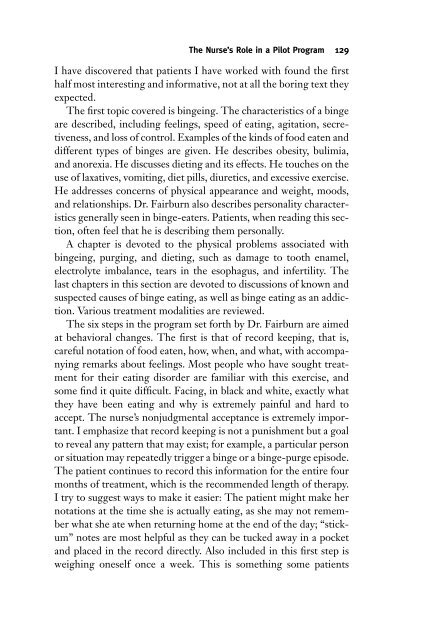Eating Disorders - fieldi
Eating Disorders - fieldi
Eating Disorders - fieldi
Create successful ePaper yourself
Turn your PDF publications into a flip-book with our unique Google optimized e-Paper software.
The Nurse’s Role in a Pilot Program 129<br />
I have discovered that patients I have worked with found the first<br />
half most interesting and informative, not at all the boring text they<br />
expected.<br />
The first topic covered is bingeing. The characteristics of a binge<br />
are described, including feelings, speed of eating, agitation, secretiveness,<br />
and loss of control. Examples of the kinds of food eaten and<br />
different types of binges are given. He describes obesity, bulimia,<br />
and anorexia. He discusses dieting and its effects. He touches on the<br />
use of laxatives, vomiting, diet pills, diuretics, and excessive exercise.<br />
He addresses concerns of physical appearance and weight, moods,<br />
and relationships. Dr. Fairburn also describes personality characteristics<br />
generally seen in binge-eaters. Patients, when reading this section,<br />
often feel that he is describing them personally.<br />
A chapter is devoted to the physical problems associated with<br />
bingeing, purging, and dieting, such as damage to tooth enamel,<br />
electrolyte imbalance, tears in the esophagus, and infertility. The<br />
last chapters in this section are devoted to discussions of known and<br />
suspected causes of binge eating, as well as binge eating as an addiction.<br />
Various treatment modalities are reviewed.<br />
The six steps in the program set forth by Dr. Fairburn are aimed<br />
at behavioral changes. The first is that of record keeping, that is,<br />
careful notation of food eaten, how, when, and what, with accompanying<br />
remarks about feelings. Most people who have sought treatment<br />
for their eating disorder are familiar with this exercise, and<br />
some find it quite difficult. Facing, in black and white, exactly what<br />
they have been eating and why is extremely painful and hard to<br />
accept. The nurse’s nonjudgmental acceptance is extremely important.<br />
I emphasize that record keeping is not a punishment but a goal<br />
to reveal any pattern that may exist; for example, a particular person<br />
or situation may repeatedly trigger a binge or a binge-purge episode.<br />
The patient continues to record this information for the entire four<br />
months of treatment, which is the recommended length of therapy.<br />
I try to suggest ways to make it easier: The patient might make her<br />
notations at the time she is actually eating, as she may not remember<br />
what she ate when returning home at the end of the day; “stickum”<br />
notes are most helpful as they can be tucked away in a pocket<br />
and placed in the record directly. Also included in this first step is<br />
weighing oneself once a week. This is something some patients









